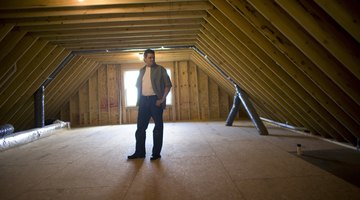DIY Attic Temperature Monitoring
Attics act as a buffer between interior living spaces and the outdoor environment. They accumulate a great deal of heat and moisture that rises from the floors below. This heat and moisture can deteriorate roof structures and materials over time.

Things You Will Need
- Temperature gauge
- Nail
- Hammer
- Aluminum foil
Proper attic ventilation removes this excess heat and keeps air flowing in the attic to remove moisture and humidity. Do-it-yourself attic temperature monitoring will indicate whether additional methods of ventilation are required. Many devices are available to increase attic ventilation, including passive vents, power fans and solar fans.
-
Choose the type of temperature monitor for your needs. Some monitors are simple temperature indicators, while others allow for remote reading of the gauge from outside the attic. Other types contain a gauge to measure the humidity level of the attic area.
-
Hang the temperature monitor at a midrange level in the attic space where it is neither close to the floor of the attic nor near the roof area.
-
Record the temperature in the attic on a hot day in the afternoon. If the temperature is more than 50 degrees Fahrenheit more than the outside temperature, you should install more ventilation in the attic, according to the Home Energy Place website.
-
Record other temperatures throughout the day. For instance, take a reading at sunset, when the attic heat is greatest.
-
Measure the temperature of other areas of the attic to determine if attic venting is variable in different areas of the attic. These measurements will allow you to determine where more venting is needed.
Tip
Electronic temperature gauges are available in hardware and home improvement stores. Choose one in your price range that is easy to install and read. Large differences between the attic temperature and the outside ambient temperature are a good indication that you need to increase the insulation in your attic and to add more heating vents. Additional air vents in the attic can be an effective way to reduce heat loss and condensation in attic areas.
Warning
Avoid locating temperature monitors close to any attic surface that can radiate heat and influence the temperature measurement, according to the Attic Foil website. If you suspect that heat is radiating from attic structural surfaces and affecting the reading in part of the attic, make a cone from aluminum foil and place it, open side down, over the temperature gauge. This will block the radiant heat and allow the gauge to measure the air temperature itself.
Snow cover on the roof acts as an insulator and may affect the temperature readings in your attic.
References
Tips
- Electronic temperature gauges are available in hardware and home improvement stores. Choose one in your price range that is easy to install and read.
- Large differences between the attic temperature and the outside ambient temperature are a good indication that you need to increase the insulation in your attic and to add more heating vents. Additional air vents in the attic can be an effective way to reduce heat loss and condensation in attic areas.
Warnings
- Avoid locating temperature monitors close to any attic surface that can radiate heat and influence the temperature measurement, according to the Attic Foil website. If you suspect that heat is radiating from attic structural surfaces and affecting the reading in part of the attic, make a cone from aluminum foil and place it, open side down, over the temperature gauge. This will block the radiant heat and allow the gauge to measure the air temperature itself.
- Snow cover on the roof acts as an insulator and may affect the temperature readings in your attic.
Photo Credits
- David Sacks/Lifesize/Getty Images
- David Sacks/Lifesize/Getty Images
More Articles



